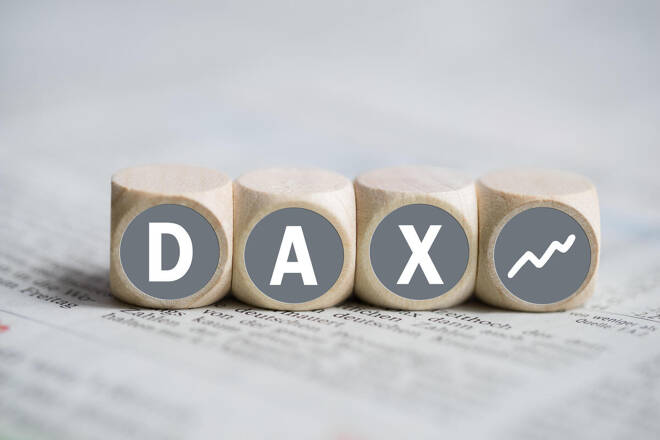Advertisement
Advertisement
DAX Index: German Wholesale Prices, Central Banks, and the Middle East in Focus
By:
German wholesale prices signal potential recession, impacting DAX Market, while ECB and Fed guidance add to buyer caution.
Highlights
- The DAX tumbled by 1.55% on Friday, ending the day at 15,187.
- Focus Shifts to German Wholesale Prices and Eurozone Trade Data on Monday.
- ECB and Fed Speeches, the NY Empire State Manufacturing Index, and news updates on the Middle East conflict also need consideration.
DAX Friday Overview
On Friday, the DAX tumbled by 1.55%. Following a 0.23% loss on Thursday, the DAX ended the day at 15,187.
US CPI Report and Fed Speeches Affected the Friday Session
Euro area economic indicators took a back seat on Friday. Investors continued to react to the hotter-than-expected US CPI Report and hawkish Fed comments.
Inflation and trade data from China added to the negative sentiment. A twelfth consecutive monthly fall in year-over-year producer prices reflected the ongoing weak demand environment. A less marked fall in exports failed to offer comfort.
Later in the European session, a slump in US consumer sentiment amid heightening inflation jitters weighed on the appetite for riskier assets. However, the market fear of other nations joining the Middle East conflict contributed to the losses.
On Friday, the Nasdaq Composite Index and the S&P 500 ended the session down 1.23% and 0.50%. The Dow gained 0.12%.
The Friday Market Movers
Sartorius AG tumbled by 13.28% after a downward revision to its full-year forecast. Bank stocks ended the day with losses despite better-than-forecasted earnings results. US banking giants JPMorgan Chase (JPM), Citigroup (C), and Wells Fargo (WFC) beat forecasts.
Commerzbank and Deutsche Bank ended the session down 2.24% and 1.48%, respectively. A negative outlook on the economy impacted demand for bank stocks.
Defense stock Rheinmetall joined several stocks in positive territory, gaining 0.17%.
Economic Indicators, Central Banks, and the Middle East in Focus
On Monday, German wholesale prices for August will kickstart the week for the DAX. A sharp fall in wholesale prices would signal a weakening demand environment. Firms reduce prices to win contracts in a low activity backdrop, which would align with expectations of a German recession.
Economists forecast German wholesale prices to fall by 4.2% year-over-year in September (August: -2.7%).
Later in the morning session, Eurozone trade data will also garner investor interest. Economists forecast the trade surplus to widen from €6.5 billion to €12.5 billion in August. Export figures and trade terms with key trading partners, including China and the US, will be focal points.
Beyond the numbers, ECB President Christine Lagarde and Executive Board members Andrea Enria and Anneli Tuominen are on the calendar to speak. Forward guidance favoring ECB rate hikes would weigh on buyer appetite for DAX-listed stocks.
However, Fed speeches and US economic indicators also warrant consideration. FOMC member Patrick Harker is on the economic calendar to speak. A pivot to a more hawkish outlook on interest rates would support more hawkish Fed interest rate bets.
While Fed speeches will remain the focal point, NY Empire State Manufacturing Index numbers may move the dial. Economists forecast the Index to fall from 1.9 to -7.0 in October. A larger-than-expected decline may spook investors and reignite fears of a hard landing.
The DAX was down 3 points, while the Nasdaq mini was up 38 points this morning.
Short-Term Forecast
Near-term trends for the DAX hinge on ECB and Fed forward guidance amid an elevated inflation environment. Economic indicators from Germany and news updates on the Middle East conflict will influence investor sentiment.
DAX Technical Indicators
Daily Chart
The DAX sat below the 50-day and 200-day EMAs, sending bearish price signals.
A break above the 15,245 resistance level would support a move toward the 200-day EMA and 15,459 resistance level. Selling pressure will likely intensify at 15,440. The 200-day EMA is confluent with the 15,459 resistance level.
Better-than-expected German wholesale prices and Eurozone trade data would drive buyer demand. However, hawkish ECB and central bank chatter and an escalation in the Middle East conflict would impact market risk appetite.
Failure to move through the 15,245 resistance level would support a move to the 15,058 support level.
The 14-day RSI reading of 41.38 indicates a DAX fall to the 15,058 support level before entering oversold territory.
4-Hourly Chart
The DAX sits below the 50-day and 200-day EMAs, sending bearish price signals. A DAX break above the 15,245 resistance level would support a move to the 50-day EMA.
However, a drop below 15,100 would bring the 15,058 support level into play.
The 41.97 14-4 hour RSI reading indicates a DAX fall to the 15,058 support level before entering oversold territory.
For a look at the economic events, check out our economic calendar.
About the Author
Bob Masonauthor
With over 28 years of experience in the financial industry, Bob has worked with various global rating agencies and multinational banks. Currently he is covering currencies, commodities, alternative asset classes and global equities, focusing mostly on European and Asian markets.
Advertisement
